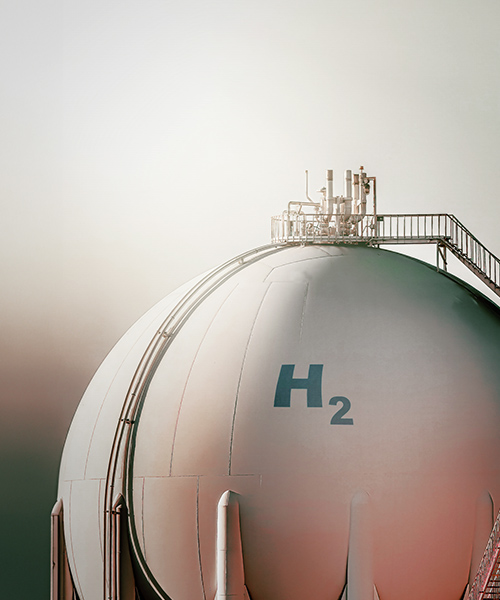December 15, 2022 • 5 min read
Power-to-X: Conquering the complexity of projects
Power-to-X can make the world’s most CO2-intensive industries more sustainable. How can aspiring producers ensure projects are achievable?
“Decarbonization is not a one-size-fits-all solution,” says Joachim Meister, Group Senior Vice President, Power and New Energy. “Energy intensive processes in industries such as steelmaking, cement, chemicals, and long-distance transport depend on heat, feedstocks for chemical reactions, and energy to drive mechanical equipment.
“Renewable electricity is part of the solution. But asset owners and transport companies need products like hydrogen, ammonia, methanol, and sustainable transport fuels, to support energy intensive processes and provide other fuels where electrification is not possible.
“This creates the need for power-to-X solutions,” continues Meister. “This group of technologies can convert renewable electricity into the lower carbon fuels and feedstocks heavy industries need.
Generating enough energy to power projects
Many new power-to-X projects will draw more electricity than almost any other industrial facility worldwide.
“We’re working on some of the largest power-to-X projects in the world, including a green ammonia project in Oman,” says Meister. “Its electricity demand exceeds the total installed capacity of Denmark. It will draw over 25 GW of electricity to produce 1.8 million tons of renewable hydrogen per year and up to 10 million tons of green ammonia per year.
“There’s currently no standalone electricity network of this size operating on renewable power alone.”
New pathways are required to overcome this challenge.
“Off-grid power-to-X projects offer power producers and plant owners opportunities to optimize these facilities,” continues Meister. “However, technology for grid stability and grid forming are critical in guaranteeing the safe and reliable operation of 100 percent renewable energy in an off-grid environment.
“If the project is grid-connected, it can provide additional value to the electricity grid and the owner, play an active role in energy supply and demand management and take advantage of volatile electricity pricing. Producing hydrogen at low cost periods and delivering renewable energy to the grid in high price periods.
“This approach can help to de-bottleneck the grid at critical connection points,” explains Meister. “The project can provide grid support services such as frequency services. Both areas can lead to additional or optimized revenue streams for the owner and reduced grid infrastructure costs at the same time.”
Integrating renewable energy into facilities
Hydro, solar, and wind power are among the most cost-competitive and sustainable forms of electricity generation available today. But as Angela Robledo, Chemicals and Fuels Senior Business Development Director explains, integrating variable renewable energy into power-to-X facilities is a technical challenge.
“If the electricity comes from wind turbines or solar panels, the output varies depending on the weather conditions. There’s a mismatch almost instantly,” says Robledo. “This is because synthesis plants that turn hydrogen into transport fuels, ammonia, or methanol need a continuous and reliable hydrogen supply to operate uninterruptedly 365 days a year.”
To solve this, producers need to install various forms of energy storage that will allow continuous production and reduce the risks of an unplanned shutdown that could impact equipment.
“The key to these projects is estimating how much storage is required to maintain a consistent electricity supply,” explains Robledo. “This includes pre-planning to assess how to keep the plant running when green electricity is unavailable, and how to handle feedstock quality changes.
“The good news for project owners is that each step of the renewable electricity generation and storage, fuel and chemical synthesis, and transport processes have been done before,” continues Robledo.
Making power-to-X projects profitable
There are also trade-offs to balance the uptime and upfront capital expenditure for these projects. Meister explains why.
“Theoretically, producers could spend millions of dollars on energy storage to integrate renewable power into their synthesis plants to keep them running 100 percent of the time. However, this level of investment would challenge a satisfactory financial return on the project, so the balance is between maximizing uptime and avoiding overinvestment.”
There are broader considerations in the early phases of power-to-X projects, too.
“These projects often have an investment horizon of multiple years,” notes Meister. “Producers can factor in technological advancements and cost reductions over time, such as innovations in electrolyzers and energy storage. But there are also potential risks from supply chain disruptions and geopolitical tensions.
“This is where commercial contracting and delivery strategies are critical. They help determine the allocation of risk and contingencies that impact cost and schedule.”
And as Meister explains, these factors are driving changes in our approach to some of the most ambitious projects in the energy transition.
“We consider the end objective, such as product target pricing, at the beginning of a power-to-X project and then work backward to find the best delivery model. It’s a reversal of the traditional project approach, but it makes sure the economics add up or trade-offs are known, no matter how pioneering the project is.
“We’re also exploring alternative delivery approaches as we believe that resources and supply chains will ultimately restrict the deployment of these large-scale projects or make them uncompetitive.”
Conquering complexity through partnerships
Collaboration between the parties in a consortium – where each brings unique areas of specialization – is a common asset for progressing power-to-X projects.
“It takes a lot of planning and expertise to get these projects right, and that’s why projects tend to involve many different organizations – across different fields – bringing their expertise to the table,” says Meister. “We’ve already encountered some of the hardest challenges the parties in these projects will face in partnership with experts, our customers, and technology providers at every stage of the project delivery process.
“These projects will make net zero achievable in some of the world’s hardest-to-abate sectors. And each technical success enables businesses in these sectors to grow their production, earn strong financial returns and meet their sustainability targets.”





